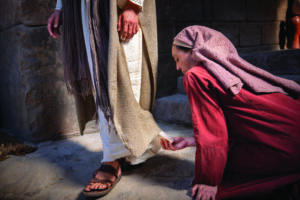
By Ken Pierce
The story of the woman with an issue of blood testifies convincingly to both the awesome power of faith placed in Jesus Christ and the importance of taking Him at His word. Unfortunately, some story elements may escape twenty-first-century readers less familiar than she was with the Tanakh (the Torah—Law, the Neve’im—Prophets, and the Ketuvim—Writings—aka, the Old Testament).
Matthew, Mark, and Luke each include an account of a woman who had suffered for many years and then found miraculous healing during an encounter with Jesus Christ. The encounter was miraculous not only because of her faith but also because of the One in whom she placed that faith—and her reason for doing so.
Though the account is brief, several points about the woman can be discerned. First, this woman knew God’s Word. She had been well taught and was convinced that God would honor His Word, including every prophetic promise concerning His Anointed One. Furthermore—and crucially—her knowledge of revealed Scripture had convinced her that Yeshua (Jesus), an itinerant rabbi from Nazareth, was the promised Messiah. Fusing those two convictions, she saw an opportunity.
In those days, a Jewish woman with a chronic issue of blood suffered virtual exile, even while continuing to live within Jewish society. The Torah stated that her condition made her ritually impure and unclean (Lev 12:1-7; 15:25-33). Through no fault of her own, she was excluded from temple life, the centerpiece of first-century Judaism. Mark and Luke note that her condition had persisted for twelve years (Mark 5:25; Luke 8:43), a number full of symbolic meaning for Israel. For this lady of great faith, the suffering must have been great. However, her condition positioned her to fulfill an extraordinary purpose: affirming Jesus of Nazareth’s identity as Israel’s Messiah to any who knew a few key passages of Scripture.
When she was healed, Jesus told her, “Be of good cheer, daughter; your faith has made you well” (Matt 9:22). But what specifically had she believed? Contrary to popular Christian teaching, “having faith” in and of itself carries no merit. The merit lies in the object of one’s faith.
The woman had heard about the itinerant Galilean Rabbi named Yeshua. She probably heard that He was a master of the Tanakh––a teacher and prophet like Moses (Deut 18:15; 34:10) who knew not just the letter but the very heart of Scripture. Moreover, the news was out that He had healed a man full of leprosy (Matt 8:2-4; Mark 1:40-45; Luke 5:12-16). On top of that, she may have heard reports that Jesus forgave and healed a paralytic (Matt 9:1-8; Mark 2:1-12; Luke 5:17-26), enabling him to get up and walk. She might also have heard a report that He healed a man disabled for nearly forty years (John 5:5-9), as well as a man with a withered hand (Matt 12:9-14; Mark 3:1-6; Luke 6:6-11). As she weighed the reports, she realized that Jesus was ticking off the scriptural “calling cards” of Messiah––trademarks and bona fides the prophets predicted so that Israel might recognize and authenticate the Messiah when, at last, He came.
The Synoptic accounts clearly show that the woman became persuaded, based on her knowledge of Scripture, that Jesus was Israel’s anointed Savior-King. The record further indicates that she believed God would honor His Holy Word (cf. Ps 138:2). When she heard that Jesus was in Capernaum, she put her faith into action. She realized that this was her golden opportunity.

Though she likely knew it well before setting out on her mission, one may imagine her meditating on one particular verse from the Prophets: “But to you who fear My name, the Sun of Righteousness shall arise with healing in His wings; and you shall go out and grow fat like stall-fed calves” (Mal 4:2). When most twenty-first-century believers read the phrase “healing in His wings,” they probably take it as a metaphor, or perhaps think of Jesus in glory, having been outfitted with a pair of wings like angels. Both understandings miss the mark.
In Mal 4:2, the Hebrew word translated “wings” is kanaph (Strong’s 3671), a word most often referring to wings of birds (e.g., Gen 1:21; Exod 19:4), or to angelic creatures (Exod 37:9; Isa 6:2; Ezek 1:6). In the Torah, however, this same word is used for the corners of tzitzit, the fringes Jewish men were to affix to the corners of their prayer shawls. The key passage is found in Num 15:38: “Speak to the children of Israel: Tell them to make tassels (tzitzit) on the corners (kanaph – literally, “the wings”) of their garments throughout their generations, and to put a blue thread in the tassels of the corners (kanaph).”
Putting these two Tanakh passages together – one from the Law, one from the Prophets (cf. Luke 24:44-45; John 5:39)–reveals something about the Messiah’s prayer shawl. According to Malachi, Messiah could be readily authenticated because those who touched the corner tassels of His garment (i.e., the wings of His prayer shawl) would find healing (cf. Matt 14:35-36). Thus, because the woman believed Jesus was the Messiah of whom the Law and the Prophets testified, and because of her faith that God would honor every detail in His Word, she acted. The rest, as the saying goes, is history.
When Jesus felt power go out of Him (Mark 5:30; Luke 8:46), He realized that someone in the crowd had identified Him as Messiah. He knew they had appropriated a healing miracle based on their faith in the Law and the Prophets concerning Him, connecting that faith to Him personally. To believe God’s Word is to believe in Jesus Christ (Rom 10:14-17). This woman had done both. First, she believed in God’s Word. Because she had done so, she also became convinced that Jesus was Israel’s long-awaited Messiah. Persuaded as to His identity, she sought Him out, she reached out her hand, and she accessed the prophesied healing that resided in His wings (Num 15:38; Mal 4:2). At that moment, her faith identified her to Jesus as a daughter who belonged to His kingdom (Matt 9:22a; cf. John 1:12; 1 John 3:1). And at that moment, her faith had made her well indeed.
____________________
Ken Pierce is a retired Navy intelligence officer with combat service in Panama, the former Yugoslavia, and Iraq. Ken studied Biblical Hebrew and Archaeology at the Jerusalem Center for Biblical Studies. After retiring from active duty, he worked as a civil servant at U.S. Strategic Command, Offutt AFB, NE, the Defense Intelligence Agency, and the Office of Naval Intelligence. In Nebraska, Ken pastored a small Bible church. Now retired, he leads a lively men’s Bible Study using Zane Hodges’ commentary on Romans, occasionally fills the pulpit for his and other pastors in NE Florida, and is contributing to a forthcoming GES commentary on the Tanakh (Old Testament). He and his wife Ana Maria recently celebrated thirty-eight years of marriage.
